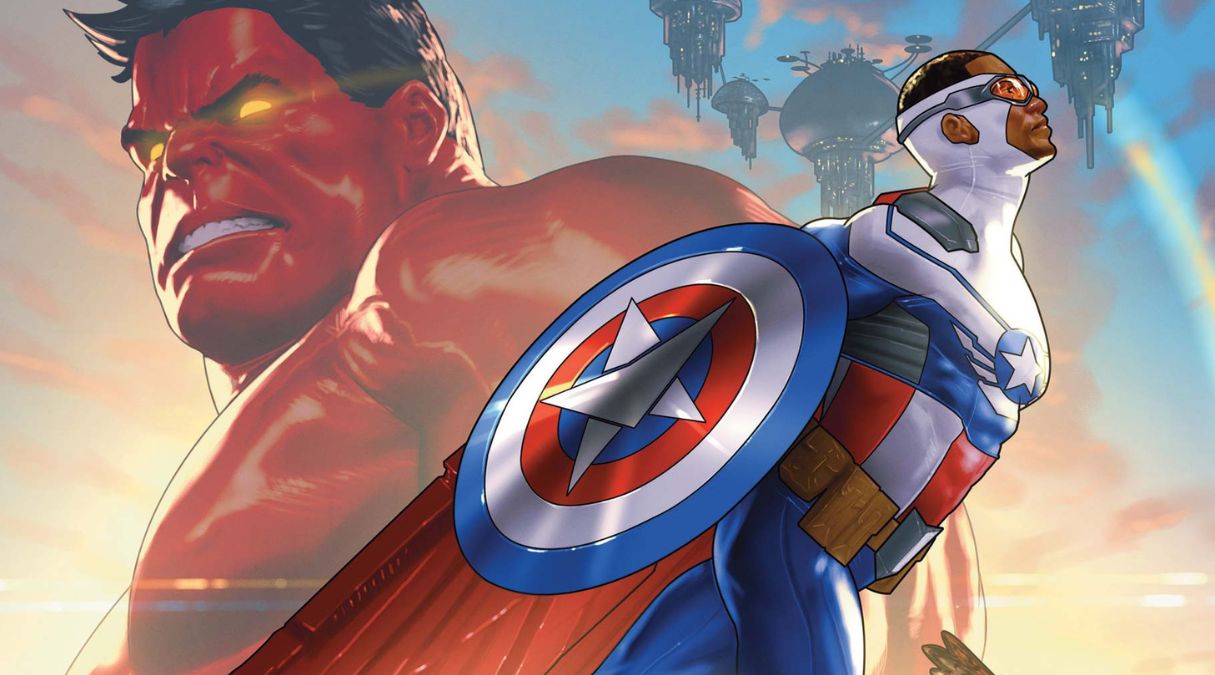Sam Wilson: Captain America Issue 1 is published by Marvel Comics. Written by Greg Pak and Evan Narcisse, with art by Eder Messias and Valentine de Landro, colors by Fer-Sifuentes Sujo, and letters by Joe Caramagna.
At a former Captain America Isaiah Bradley birthday party, Sam Wilson discovers a new city created by a former paramilitary group, with Red Hulk as their head of security.
Sam Wilson: Captain America Issue 1 has a plot split into two halves. One is a celebration of history. Isaiah Bradley is a Captain America that history hid and betrayed, abused, and mistreated by the Government for years. The first chapter of Issue 1 rips open that secret for an energetic and emotional beginning. There is even an action-packed opening that shows the book’s pace and personality.
The second half of the issue unveils a mysterious new community that appears to be righting many societal wrongs. However, this city is run by a nefarious corporation posing as philanthropy with an extremely powerful hero as backup. It’s grand, high-tech, and well-liked but with a sickly undertone.
Pak and Narcisse’s fascinating structure blends intense political commentary with an excellent superhero comic. There is a terrific understanding of racial injustice across American and Marvel history, combining them perfectly. Much of the storytelling is incredibly intelligent and well-researched. But then there are also exhilarating fight scenes that seek to tie this comic into the upcoming Captain America movie, with the ending setting up an exciting conflict.
This first issue is about more than just Sam Wilson. It’s more than the symbol of Captain America. Many black heroes make an appearance, all gathered together in one place to celebrate an absolute stalwart. The relationship between these heroes is fascinating. Many of them talk like family, sharing common ideals. The idea of generations is also huge within this issue, with more heroes of color present in Marvel now than ever.
Sam brings his cousin with him. Billie is an entry point for new readers. She absorbs information and asks the necessary questions. She is lively and inquisitive but can play with the heroes like they are old friends. The dialogue is sensational. It can be sad and mournful for past and present injustices but also fun and infectious. The villain of the issue is a smarmy business type with a whole host of secrets.
The art has a grounding quality to it, which is brilliant for the contrast within the comic. Despite superheroes and other fantastical elements, the art often includes an air of normality. The opening scene has a swarm of vampires attacking a street in Harlem. So, whilst Captain America is battling these crazy villains, there is also a direct link to his upbringing. Next is the scene with Isaiah, where the characters all arrive in costumes. They join Bradley at his modest and extremely normal house, again showing the two worlds in which Captain America and the others reside.
Then, Sam Wilson: Captain America Issue 1 moves to the new location, which is immensely futuristic. It’s a far cry from the other neighborhoods that Sam and his family have grown up in. But its pristine exterior is almost too pristine, which raises questions. The costumes of Captain America and the many other heroes present in the comic are fantastic, but they aren’t always perfect.
Sometimes, Messias struggles with the amount of detail on Sam’s head, more specifically with the mask and the flying goggles. This can sometimes make the panel messy. However, with so many characters in the early part of the comic, the ensemble pieces are impressive.
The grounded nature of Sam Wilson: Captain America Issue 1 leads to variations in the color palette. The world looks natural and recognisable, with bright blue skies, green grass, and brown tones for the neighborhoods. The superheroes have some more vibrant shades in their costumes, but they are never too extreme to be overwhelming. The issue can be more dazzling before and after Isaiah’s cookout, but not to any extremes. The lettering is very easy to read, and the SFX is fantastically creative.
Sam Wilson: Captain America Issue 1 takes its time before taking off. Although many superheroes make cameos in the issue, Pak and Narcisse is certain to keep it about Sam Wilson. Even when other situations pop up and Steve Rogers is present, Sam is left to handle business in his own way. Isaiah doesn’t say much—he can’t due to his mistreatment—but he is the other important figure.
There is a background story that directly ties into one of the talking points in the main chapter. It explores a part of American history that is huge and yet personal. It’s something that I, as a non-American, was not aware of at all. It is an example of just how many times people of color have been ignored, downtrodden, and abused over time. But there is also a sense of freedom to this story, with a tale being told in the past and present to show just what has changed in that time. But recognising change does not ever negate the past.
This opening chapter doesn’t contain scathing anger; it is a celebration. It’s more about remembering than trying to get vengeance for anything. It’s warm and welcoming, with exciting action sequences, too. Captain America remembers the community that came before the costumes.
Sam Wilson: Captain America Issue 1 is available where comics are sold.
Sam Wilson: Captain America Issue 1
TL;DR
This opening chapter doesn’t contain scathing anger; it is a celebration. It’s more about remembering than trying to get vengeance for anything. It’s warm and welcoming, with exciting action sequences, too. Captain America remembers the community that came before the costumes.

